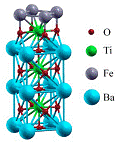Department of Physics and Astronomy: Publications and Other Research

Evgeny Tsymbal Publications
ORCID IDs
Tsymbal http://orcid.org/0000-0002-6728-5493
Document Type
Article
Date of this Version
3-2000
Citation
Physical Review B (2000) 62: 3,952-3,959
Abstract
A detailed first-principles study of the atomic and electronic structure of the Co/Al2O3/Co magnetic tunnel junction has been performed in order to elucidate the key features determining the spin-dependent tunneling. The atomic structure of the multilayer with the O- and Al-terminated interfaces between fcc Co(111) and crystalline α-Al2O3(0001) has been optimized using self-consistent spin-polarized calculations within densityfunctional theory and the generalized gradient approximation. We found that the relaxed atomic structure of the O-terminated interface is characterized by a rippling of the Co interfacial plane, the average Co-O bond length being 2.04 Å which is within 5% of that in bulk CoO. The corresponding electronic structure is influenced by the covalent bonding between the O 2p and Co 3d orbitals resulting in exchange-split bonding and antibonding states and an induced magnetic moment of 0.07 µB on the interfacial oxygen atoms. The Al-terminated interface contains Co-Al bonds with an average bond length of 2.49 Å compared to 2.48 Å in bulk CoAl. Due to charge transfer and screening effects the Co interfacial layer acquires a negative charge which results in a reduced magnetic moment of 1.15 µB per Co atom. We found that the electronic structure of the O-terminated Co/Al2O3/Co tunnel junction exhibits negative spin polarization at the Fermi energy within the first few monolayers of alumina but it eventually becomes positive for distances beyond 10 Å.


Comments
Copyright © 2000, American Physical Society. Used by permission